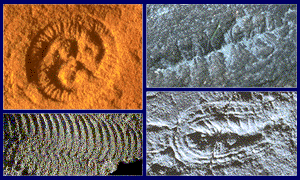
The
Fossil
Record
As geologists continued to reconstruct the Earth's geologic history in the 1700s and early 1800s, they quickly recognized that the distribution of fossils within this history was not random -- fossils occurred in a consistent order. This was true at a regional, and even a global scale. Furthermore, fossil organisms were more unique than rock types, and much more varied, offering the potential for a much more precise subdivision of the stratigraphy and events within it.
The recognition of the utility of fossils for more precise "relative dating" is often attributed to William Smith, a canal engineer who observed the fossil succession while digging through the rocks of southern England. But scientists like Albert Oppel hit upon the same principles at about about the same time or earlier. In Smith's case, by using empirical observations of the fossil succession, he was able to propose a fine subdivision of the rocks and map out the formations of southern England in one of the earliest geological maps (1815). Other workers in the rest of Europe, and eventually the rest of the world, were able to compare directly to the same fossil succession in their areas, even when the rock types themselves varied at finer scale. For example, everywhere in the world, trilobites were found
lower in the stratigraphy than marine reptiles. Dinosaurs were found after the first occurrence of land plants, insects, and amphibians. Spore-bearing land plants like ferns were always found before the occurrence of flowering plants. And so on.
The observation that fossils occur in a consistent succession is known as the "principle of faunal (and floral) succession". The study of the succession of fossils and its application to relative dating is known as "biostratigraphy". Each increment of time in the stratigraphy could be characterized by a particular assemblage of fossil organisms, formally termed a biostratigraphic "zone" by the German paleontologists Friedrich Quenstedt and Albert Oppel. These zones could then be traced over large regions, and eventually globally. Groups of zones were used to establish larger intervals of stratigraphy, known as geologic "stages" and geologic "systems". The time corresponding to most of these intervals of rock became known as geologic "ages" and "periods", respectively. By the end of the 1830s, most of the presently-used geologic periods had been established based on their fossil content and their observed relative position in the stratigraphy (e.g., Cambrian (1835), Ordovician (1879), Silurian (1835), Devonian (1839), Carboniferous (1822), Permian (1841), Triassic (1834), Jurassic (1829), Cretaceous (1823), Tertiary (1759), and Pleistocene (1839)). These terms were preceded by decades by other terms for various geologic subdivisions, and although there
was subsequent debate over their exact boundaries (e.g., between the Cambrian and Silurian Periods, which was resolved by proposal of the Ordovician Period between them), the historical descriptions and fossil succession would be easily recognizable today.
By the 1830s, fossil succession had been studied to an increasing degree, such that the broad history of life on Earth was well understood, regardless of the debate over the names applied to portions of it, and where exactly to make the divisions. All paleontologists recognized unmistakable trends in morphology through time in the succession of fossil organisms. This observation led to attempts to explain the fossil succession by various mechanisms. Perhaps the best known example is Darwin's theory of evolution by natural selection. Note that chronologically, fossil succession was
well and independently established long before Darwin's evolutionary theory was proposed in 1859. Fossil succession and the geologic time scale are constrained by the observed order of the stratigraphy -- basically geometry -- not by evolutionary theory.1
Radiation Measurement
Stratigraphic Superposition
Geological Time Main Page
1Radiometric Dating and the Geological Time Scale
http://www.talkorigins.org/faqs/dating.html
|

